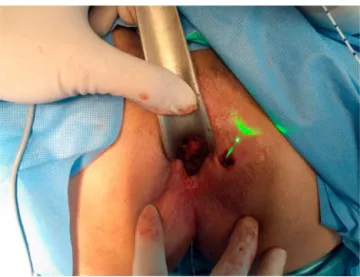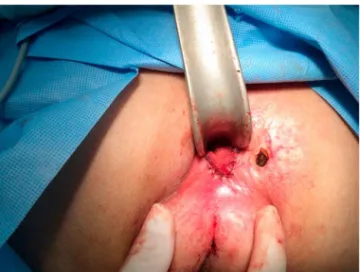jcoloproctol(rioj).2017;37(2):160–162
w w w . j c o l . o r g . b r
Journal
of
Coloproctology
Technical
Note
FILAC
–
Fistula
–
Tract
Laser
Closure:
a
sphincter-preserving
procedure
for
the
treatment
of
complex
anal
fistulas
Alexandre
Lopes
de
Carvalho
a,∗,
Eduardo
Fonseca
Alves
Filho
b,
Rogerio
Souza
Medrado
de
Alcantara
b,
Marcelo
da
Silva
Barreto
baHospitaldaBahia,Servic¸odeColoproctologia,Salvador,BA,Brazil bHospitalPortuguês,Servic¸odeColoproctologia,Salvador,BA,Brazil
a
r
t
i
c
l
e
i
n
f
o
Articlehistory:
Received13July2016 Accepted27March2017 Availableonline19April2017
Keywords:
FILAC
Laseranalfistula Analfistula
a
b
s
t
r
a
c
t
Severalsurgicaloptionsaredescribedforthetreatmentofanorectalfistulas,particularly incomplexcaseswhererecurrenceratesandthepossibilityofpostoperativeincontinence arestillhigh.TheaimofthisstudyistodescribetheuseofFILACtechnique(Fistula–Tract LaserClosure)minimallyinvasiveandpreservationsphinctertechnique.FILAChasbeen describedintheliteratureasanoptioninthemanagementofanorectalfistula.
©2017SociedadeBrasileiradeColoproctologia.PublishedbyElsevierEditoraLtda.This isanopenaccessarticleundertheCCBY-NC-NDlicense(http://creativecommons.org/ licenses/by-nc-nd/4.0/).
FILAC
–
Fechamento
do
trajeto
da
fístula
à
laser:
Procedimento
de
preservac¸ão
esfincteriana
para
o
tratamento
das
fístulas
anais
complexas
Palavras-chave:
FILAC
Laserfístulaanal Fístulaanal
r
e
s
u
m
o
Váriasopc¸õescirúrgicassãodescritasparaotratamentodefístulasanorretais, especial-menteemcasoscomplexos,ondeastaxasderecorrênciaeapossibilidadedeincontinência pós-operatóriaaindasãoelevadas.OobjetivodesteestudoédescreverousodatécnicaFILAC (Fechamentodotrajetodafístulaàlaser),técnicaminimamenteinvasivacompreservac¸ão esfincteriana.FILACtemsidodescritonaliteraturacomoumaopc¸ãonomanejodafistula pcolerianal.
©2017SociedadeBrasileiradeColoproctologia.PublicadoporElsevierEditoraLtda.Este ´eumartigoOpenAccesssobumalicenc¸aCCBY-NC-ND(http://creativecommons.org/ licenses/by-nc-nd/4.0/).
∗ Correspondingauthor.
E-mail:alexandrelc1@gmail.com(A.L.Carvalho).
http://dx.doi.org/10.1016/j.jcol.2017.03.001
jcoloproctol(rioj).2017;37(2):160–162
161
Introduction
The anorectal fistulas have been described for more than 2500years. Itis anepithelialized path thatcommunicates theanalcanaltotheperianalskin.Itsestimatedincidence is68,000–96,000newcasesperyearintheUnitedStates.1The
averageageofonsetisabout40yearsandismoreprevalent inmenthaninwomeninanestimatedratioof2:1to7:1.2The
treatmentisbasicallysurgeryfortheprimaryfistula,which hasnoconcomitantconditions,suchasinflammatorybowel disease,tuberculosis,neoplasia,etc.
Itsmanagementhasbeenachallengeforcolorectal sur-geons and the possibility of recurrence and postoperative incontinenceremains high incomplex cases, especially in hightransphinctericfistulas,suprasphinctericfistulas, recur-rentcasesandinwomen.
Themostused techniques are fistulotomy and fistulec-tomywithsimilarratesofrecurrenceandrelapse;5and7%, respectively.Incontinenceiscommonlyreportedas involun-taryleakageofmucusandflatusandlessfrequentlyfeces.2
New methods have recently been incorporated for the treatmentoffistulas(LIFT–LigationIntersphinctericFistula Tract and VAAFT – Video Assisted Anal Fistula Treatment) and differentimplants to occlude path(plugs and glue) in an attempt to become less invasive surgery and preserve sphincter.3 Althoughtheriskofincontinenceisminimalin
suchcasestherecurrencerateishigherwhencomparedto traditionaltechniques.
Thediodelaserhasbeenusedinvariousareasofmedicine (Urology,Otorhinolaringology, Gynecology,Vascularsurgery, Neurosurgery)and wasalsoincorporated inColoproctology throughFILAC(Fistula–TractLaserClosure),sealingand clo-sureofthefistulathroughLaser.
Material
and
methods
Surgicaltechnique
Thepatientunderwentspinalanesthesiaandispositionedin lithotomy.AntibioticprophylaxiswithUnasyn3gandbowel preparationwithrectalenemaonedaybeforesurgery.After recognitionoftheexternalorifice,fistulaecatheterizationis performed with probe, cleaning with saline irrigation and miomucosalflapwithresectionoftheinternalorifice.
Introduction of the laser fiber through the external to the internal orifice, activation of laser and gradual with-drawal5mmfiberevery3s,fromtheinternaltotheexternal orifice withsimultaneous destruction and sealingofpaths (Figs.1and2).Thefiberlaserdiodeusedisaradialemission wavelength1470nm(FILACfistulaprobe,Biolitec,Germany). TheBIOLITECLEONARDOgeneratorwassetto13W continu-ously(Fig.3).
Atthe end of the procedure, the miomucosal flap was sutured,coveringthe areaoftheinternalorifice andmade resectionof the externalorifice forproper drainage ofthe wound(Figs.4and5).
Fig.1–Activationoflaserfiber.
Fig.2–Activationoflaserfiber.
162
jcoloproctol(rioj).2017;37(2):160–162Fig.4–Finalaspectofprocedure.
Fig.5–Woundhealed.
Discussion
TheuseofFILACforthetreatmentofanorectalfistulahas shownencouraging.Thetechniqueiseasytolearnandfast toperform,allowsexplorationofcurvedpathsandanysize sincethefiberisveryflexibleandlong.Thedestructionofthe epithelializedpathandsealingiscarriedoutbylaseremission radially360◦,therebyallowingtheapplicationofenergyacross
thepathhomogeneousinacontrolledmanner.
This procedure can be combined with other tech-niques that close the internal orifice as miomucosal flap
advancement.Thesealingofthepathmaybeaccompanied byendorectalultrasoundifnecessary,withgoodvisibilityof thefiber.
FILAC success in healing anorectal fistulas in different studiesintheliteratureis71–82%,4–7withameanof30months
inthestudywithlongerobservationtime.4Amongtheadverse
events reported, pain, tenesmus and soiling are the most common. Therewas no change incontinence inanorectal manometry.7Noseriouscomplicationswerereportedinthe
studies.
Theneedforprioruseofsetonsandtheoptimaltreatment oftheinternalorifice,eithermiomucosaladvancementflap, simplestitchesorleavesit open,isnotwelldefinedinthe literature.
Giamundoetal.recommendstheuseofsetons preopera-tively,bearinginmindthatthehealingrateinthesubgroupof oneofhisworks7washigherinpatientswhousedtheSeton
compared tothose who didnot use the Seton (81%×63%,
respectively).Thisobservationshouldbeviewedwithcaution duetothesmallnumberofpatientsandthecharacteristics inherentinthestudy.
Amajordisadvantageofthismethodisthecostoflaser fiber,whichisstillquitehighinourcountry.
Conclusion
TheFILAC,sphincterpreservationminimallyinvasivesurgery inthe treatmentofanal fistulas,lookspromisingalthough prospectiveandlong-termfollow-upstudiesshouldbe con-ducted.
Conflicts
of
interest
Theauthorsdeclarenoconflictsofinterest.
r
e
f
e
r
e
n
c
e
s
1.AbcarianH.Analfistula:principlesandmanagement.Springer Science&BusinessMedia;2013.
2.GordonPH,NivatvongsS,MulhollandMW.Principlesand practiceofsurgeryforthecolon,rectum,andanus.Shock. 1999;12:328.
3.LimuraE,GiordanoP.Modernmanagementofanalfistula. WorldJGastroenterol.2015;21:12–20.
4.GiamundoP,EsercizioL,GeraciM,TibaldiL,ValenteM. Fistula-tractLaserClosure(FiLaCTM):long-termresultsand newoperativestrategies.TechColoproctol.2015;19:449–53.
5.WilhelmA.Anewtechniqueforsphincter-preservinganal fistularepairusinganovelradialemittinglaserprobe.Tech Coloproctol.2011;15:445–9.
6.OztürkE,GülcüB.Laserablationoffistulatract:a
sphincter-preservingmethodfortreatingfistula-in-ano.Dis ColonRectum.2014;57:360–4.

